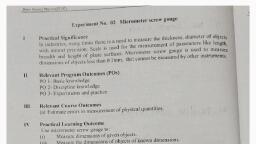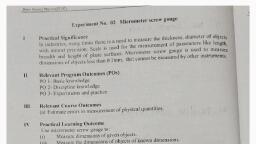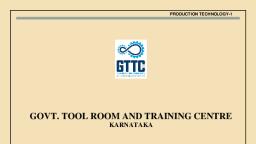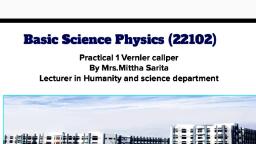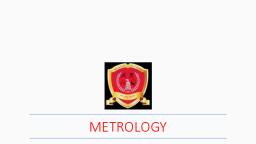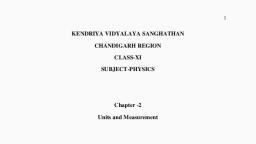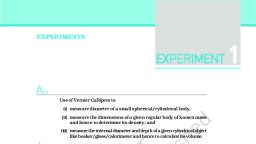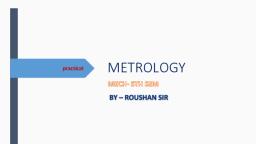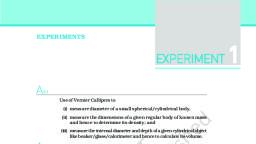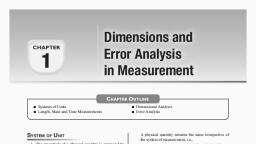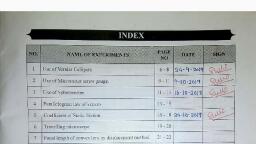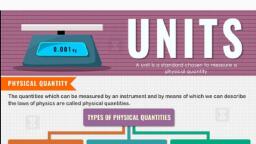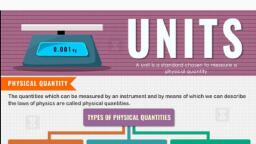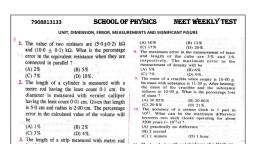Page 1 :
Il, , i, , IV, , Vv, , VI, , Vil, , Experiment No. 1 Vernier Caliper, , Practical Significance, , In industries measurement of inner diameter, ov n f Pei, objects with utmost accuracy and precision is 4 prime requirement. be i:, measurement of the objects having dimensions less than Imm or to measure ie, dimensions of curved surfaces, normal scales cannot be used. Such kind of, measurements are possible using measuring instruments like Venier caliper,, micrometer screw gauge etc. In this lab experience we use Vernier caliper to measure, , the dimensions of objects in centimeters up to two significant figures., , uter diameter, height and depth of, , Relevant Program Outcomes (POs), PO1- Basic knowledge, PO3- Experiments and practice, , Relevant Course Outcomes ;, (a) Estimate errors in measurement of physical quantities., , Practical Learning Outcome, , Use Vernier caliper to:, , (i) Measure dimensions of given objects., , (ii) Measure the dimensions of objects of known dimensions., (iii) Estimate the errors in measurement., , Practical Skills, a. Measurement skills, b. Error estimation skills, , Relevant Affective domain related Outcomes, a. Handle tools and equipment carefully., b. Select proper instrument., , Minimum Theoretical Background, , Vernier Caliper is an instrument used to measure dimensions such as inner diameter,, outer diameter, height, depth, thickness of an object. Least count (L.C) of instrument is, the smallest measurement that can be taken by using an instrument. Range of Vernier, caliper is the maximum measurement that can be taken by using the instrument. There, are two separate scales on Vernier caliper namely Main Scale and Vernier scale, Least, count of Vernier Caliper is given by, , Ve ivisi nscale, LC of vernier caliper = ‘alue of Smallest division on main scale (m), , Total no. of divisions on vernier scale (n), , Zero error occurs in an instrument due to non coincidence of zero of main scale with, zero of vernier scale when the jaws are closed., , MAHARASHTRA STATE BOARD OF TECHNICAL EDUCATION, , aie
Page 2 :
Basic Science Physic ), , i sh uation:, VIL Circuit diagram Experimental set-up’/ Work Situa e, , seis — HEN, , raleitis, , , , Figure 18, , Figure 1A :, Inner diameter of hollow cylinder, , Outer dimensions of the object, , 1.0cm, , Main oO 0.5, scale _—p, Vernier—> 10, , elon No zero error, Main o 0.5 1.0cm, scale—_p, Vemier—>, 1 10, og Positive zero error, Main oO 0.5 1,0cm, , scale—_p, Vernier—> AG, , scale O ., Negative zero error, , , , , , , , , , , , , , , , , , , , , , , , , , Figure 2, Ix Resources required, S. Instrument /Object | Specification Quantity | Remarks, No., 1. | Vernier Caliper L.C.=0,002cem 1 No. whichever is available, Range=0-15cm, 2. | Hollow Cylindrical | Any dimensions 1 No. - Available dimensions, Pipe, 3. | Rectangular wooden | Any dimensions 1 No. Available dimensions, block :, 4. | Hollow pipe 16 gauge thickness | | No. whichever is available, X Procedure, PartI, , 1. Identify each part of the instrument., , 2. Find the least count of given Vernier calipers using the formula given in the, theoretical background., , 3. Find the zero error (z) of given Vernier caliper as given in Rie 02., , 4. Hold the given object in the appropriate jaws depending upon the parameter to be, measured,, , 5. Observe the zero of the Vernier scale and take main scale reading (MSR)., , , , MAHARASHTRA STATE BOARD OF TECHNICAL EDUCATION, , f i, , 2
Page 3 :
Basic Science Physics (22102), , ae . ‘ it, 6. Check the division of Vernier scale coinciding with the main scale and note !, down as (VSD). ey, Find the vernier scale reading; VSR = (VSD x LC. ', Calculate the total reading using the formula: Total reading (TR) = MSR+VSR., , Calculate the corrected reading = TR+z, , eam, , Part Il, , 1. Take the object of known dimension. aS, , 2. Find the dimensions of the object using same method as explained in Part I., , 3, Compare the obtained value of the dimension considered with its known value., , 4. Estimate the error in the measurement, if any., , XI _- Precautions ‘ j p, 1. The jaws of Vernier caliper should not be pressed hard while taking the readings., n scale should be, , 2. The division of Vernier scale exactly coinciding with the mai, , noted down accurately., 3, Parallax should be removed., , , , XII Actual procedure followed, , , , ay) aah, ay aN, , , , MAHARAS|, HTRA STATE BOARD OF TECHNICAL EDUCATION, +3
Page 5 :
XVIL. Interpretation of results, , Error in the measurement= [Known (standard) value- Experimental value], = 3/72 On0b 5, 018, , XVIII. Conclusions and Recommendations, , XIX., , , , Practical related Questions, Note: Below given are few sample questions for reference. Teachers must design, more such questions so as to ensure the achievement of identified CO., 1. Give the value of smallest division on main scale and the total no. of divisions on, Vernier scale of the instrument used in experiment., 2. Write the range of the Vernier caliper used in the experiment., 3. Give reasons for°using upper jaws of the Vernier Calipers to find the inner, diameter of cylindrical pipe., 4. Determine the least. count (L.C.) of Vernier caliper if smallest division on main, scale is Imm and the number of divisions on Vernier scale is 50., 5. A student has used a Vernier caliper with LC 0.01cm, to measure the length of his, - pencil. He found that the main scale showed a reading of 8.3 cm and Vernier scale, coincides with 5" position to the main scale. Give the correct measurement of the, length of the pencil neglecting zero error. ; hay, , , , , , , , , , , , , , , , , , XX. References / Suggestions for further Reading, a. amrita.olabs.edu.in/?sub=] &brch=S&sim=16&cnt=1, b. _ https://www.youtube.com/watch?v=zqCkb800_wY, c. mptbe.nic.in/experiments-py-11.pdf, XXI._ Assessment Scheme, Process related with Weightage (Criteria considered:60%), S: Particulars of the process Weightage |, No., 1. | Handling of the instrument 10, 2. | Determination of Least Count(L.C.) of instrument 10, 3._| Determination of zero error of instrument 10, 4. | Fixing of object 10, 5._| Proper measurement 10., 6._| Calculation of parameters concerned 10, , , , , , , , Product related with Weightage (Criteria considered:40%)

